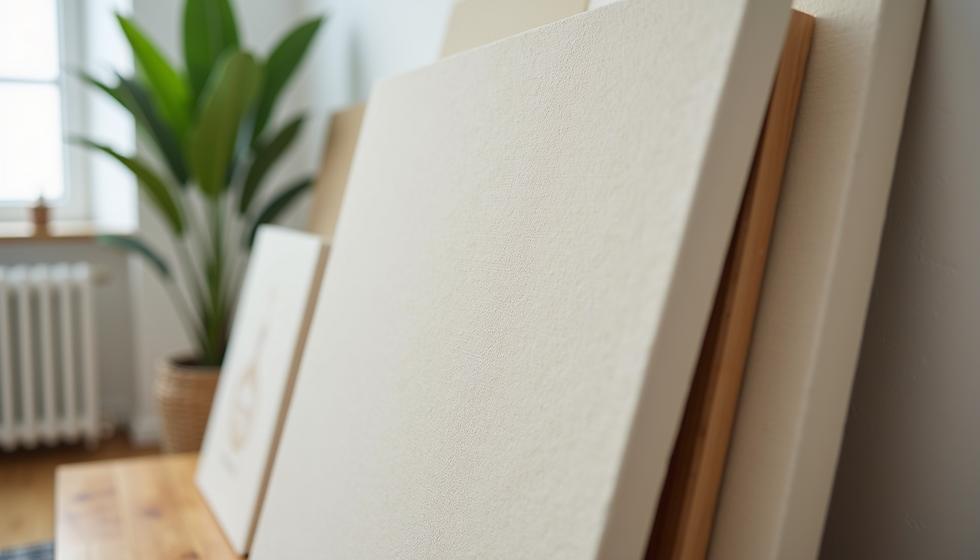Choosing the Perfect Blank Canvas for Your Next Artwork
- hello84219
- Apr 10
- 2 min read
Updated: Jun 26

Selecting the right canvas is essential for both artists and clients. The choice of canvas impacts the texture, durability, and presentation of the artwork. This guide will assist you in making an informed decision.
Understanding the Importance of Canvas Material
1. Canvas Material: What’s the Best Base?
Cotton Canvas
Pros: Affordable, lightweight, and great for beginners.
Cons: Less durable than linen; may sag over time.
Best for: Practice pieces, studies, and short-term projects.
Linen Canvas
Pros: Stronger, more durable, and has a smoother surface.
Cons: More expensive than cotton.
Best for: Professional artists and high-end commissions.
Synthetic Blends (Polyester, Poly-Cotton)
Pros: Resistant to moisture and warping.
Cons: Less traditional feel; may not hold paint as well.
Best for: Outdoor use or high-humidity environments.
2. Canvas Texture: Smooth or Rough?
The texture of your canvas influences how paint interacts with it.
Fine/Medium Texture: Ideal for detailed work like portraits and realism.
Rough/Heavy Texture: Great for expressive brushstrokes found in impressionism or abstract art.
Primed vs. Unprimed:
- Primed: Pre-coated with gesso; ready for acrylic or oil paints.
- Unprimed: Needs gesso before use; this is preferred for those seeking custom textures.
3. Stretched vs. Unstretched Canvas
Stretched Canvas
Pros: Ready to hang or display.
Standard Sizes: Easy to frame and fit into various spaces.
Best for: Finished works and commissioned pieces.
Unstretched (Canvas Rolls or Panels)
Pros: More affordable and allows for customization.
Cons: Requires stretching or mounting later.
Best for: Large-scale murals or to save on storage.
4. Choosing the Right Size & Shape
Selecting dimensions may depend on your project:
Small (8x10" – 16x20"): Perfect for sketches or small decor pieces.
Medium (18x24" – 24x36"): A standard size suitable for most artworks.
Large (30x40" and up): Ideal for statement pieces or gallery works.
Custom Shapes: Think square, circular, or panoramic for unique compositions.
5. Pre-Stretched vs. DIY Stretching
Pre-Stretched: Convenient but limited options for customization.
DIY Stretching: Offers more control over tension and depth; great for professional artists.
6. Budget Considerations
Student-Grade: These options are affordable but may degrade faster.
Professional-Grade: Higher quality and archival, designed to last longer.
Final Tip: Always Consider the Final Use!
When completing a commission, discuss with the client whether they prefer a gallery-wrapped piece or one that is framed. If working on personal projects, try experimenting with different textures and materials to find what best suits your needs.
Inspiration: Explore and Experiment
Don't limit yourself to one type of canvas. Exploring different materials can lead you to unexpected and exciting results in your artwork. The right canvas can enhance your creativity and elevate the final piece.
Ready to Start Your Masterpiece?
Now that you understand how to choose the perfect canvas, it’s time to bring your vision to life! Whether it’s a personal project or a professional commission, having the right foundation is crucial. If you’re interested in more details, consider the options available here.
Have Questions?
Feel free to drop them in the comments below! 🎨
⬇⬇⬇⬇⬇⬇⬇⬇⬇⬇⬇⬇⬇⬇⬇⬇⬇⬇⬇⬇⬇⬇⬇⬇⬇⬇⬇⬇⬇⬇⬇⬇⬇⬇⬇⬇⬇⬇⬇⬇⬇⬇⬇⬇





Comments